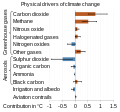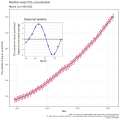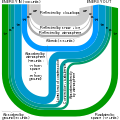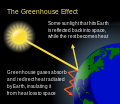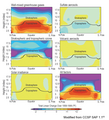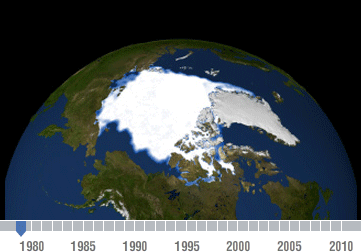
Back Portal:Klimawandel German Portail:Changement climatique French Portaal:Opwarming van de Aarde Dutch Cổng thông tin:Biến đổi khí hậu Vietnamese
The Climate Change Portal Present-day climate change includes both global warming—the ongoing increase in global average temperature—and its wider effects on Earth’s climate system. Climate change in a broader sense also includes previous long-term changes to Earth's climate. The current rise in global temperatures is driven by human activities, especially fossil fuel burning since the Industrial Revolution. Fossil fuel use, deforestation, and some agricultural and industrial practices release greenhouse gases. These gases absorb some of the heat that the Earth radiates after it warms from sunlight, warming the lower atmosphere. Carbon dioxide, the primary gas driving global warming, has increased in concentration by about 50% since the pre-industrial era to levels not seen for millions of years. Climate change has an increasingly large impact on the environment. Deserts are expanding, while heat waves and wildfires are becoming more common. Amplified warming in the Arctic has contributed to thawing permafrost, retreat of glaciers and sea ice decline. Higher temperatures are also causing more intense storms, droughts, and other weather extremes. Rapid environmental change in mountains, coral reefs, and the Arctic is forcing many species to relocate or become extinct. Even if efforts to minimize future warming are successful, some effects will continue for centuries. These include ocean heating, ocean acidification and sea level rise. Climate change threatens people with increased flooding, extreme heat, increased food and water scarcity, more disease, and economic loss. Human migration and conflict can also be a result. The World Health Organization calls climate change one of the biggest threats to global health in the 21st century. Societies and ecosystems will experience more severe risks without action to limit warming. Adapting to climate change through efforts like flood control measures or drought-resistant crops partially reduces climate change risks, although some limits to adaptation have already been reached. Poorer communities are responsible for a small share of global emissions, yet have the least ability to adapt and are most vulnerable to climate change. Many climate change impacts have been observed in the first decades of the 21st century, with 2024 the warmest on record at +1.60 °C (2.88 °F) since regular tracking began in 1850. Additional warming will increase these impacts and can trigger tipping points, such as melting all of the Greenland ice sheet. Under the 2015 Paris Agreement, nations collectively agreed to keep warming "well under 2 °C". However, with pledges made under the Agreement, global warming would still reach about 2.8 °C (5.0 °F) by the end of the century. Limiting warming to 1.5 °C would require halving emissions by 2030 and achieving net-zero emissions by 2050. Fossil fuel use can be phased out by conserving energy and switching to energy sources that do not produce significant carbon pollution. These energy sources include wind, solar, hydro, and nuclear power. Cleanly generated electricity can replace fossil fuels for powering transportation, heating buildings, and running industrial processes. Carbon can also be removed from the atmosphere, for instance by increasing forest cover and farming with methods that capture carbon in soil. (Full article...) Selected article –Climate engineering (or geoengineering, climate intervention) is the intentional large-scale alteration of the planetary environment to counteract anthropogenic climate change. The term has been used as an umbrella term for carbon dioxide removal, weather as a weapon, reduction of pole ice and solar radiation modification when applied at a planetary scale. However, these two processes have very different characteristics, and are now often discussed separately. Carbon dioxide removal techniques remove carbon dioxide from the atmosphere, and are part of climate change mitigation. Solar radiation modification is the reflection of some sunlight (solar radiation) back to space to cool the earth. Some publications include passive radiative cooling as a climate engineering technology. The media tends to also use climate engineering for other technologies such as glacier stabilization, ocean liming, and iron fertilization of oceans. The latter would modify carbon sequestration processes that take place in oceans. Some types of climate engineering are highly controversial due to the large uncertainties around effectiveness, side effects and unforeseen consequences. Interventions at large scale run a greater risk of unintended disruptions of natural systems, resulting in a dilemma that such disruptions might be more damaging than the climate damage that they offset. However, the risks of such interventions must be seen in the context of the trajectory of climate change without them. (Full article...) Selected picture –This image shows the Arctic as observed by the Advanced Microwave Scanning Radiometer for EOS (AMSR-E) aboard NASA’s Aqua satellite on September 16, 2007. The image denotes a record sea ice minimum in the Arctic.
WikiProjectsIn the newsAdditional News
Selected biography –Karen Christiana Figueres Olsen (born 7 August 1956) is a Costa Rican diplomat who has led national, international and multilateral policy negotiations. She was appointed Executive Secretary of the UN Framework Convention on Climate Change (UNFCCC) in July 2010, six months after the failed COP15 in Copenhagen. During the next six years she worked to rebuild the global climate change negotiating process, leading to the 2015 Paris Agreement, widely recognized as a historic achievement. Over the years Figueres has worked in the fields of climate change, technical and financial cooperation, energy, land use and sustainable development. In 2016, she was Costa Rica's candidate for the United Nations Secretary General and was an early frontrunner, but decided to withdraw after garnering insufficient support. She is a founder of the Global Optimism group, co-author of The Future We Choose: Surviving the Climate Crisis (2020) along with Tom Rivett-Carnac, and co-host of the popular podcast Outrage and Optimism. (Full article...) General imagesThe following are images from various climate-related articles on Wikipedia.
Did you know –Related portalsWeb resources
Things to do
WikimediaReferences
Discover Wikipedia using portals
|




